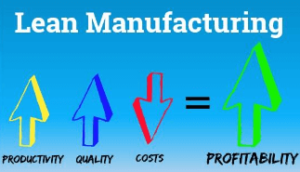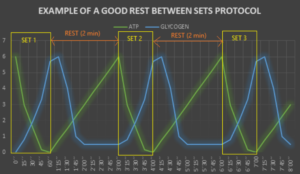Lean Manufacturing for training optimization is important. The ‘Lean manufacturing’ philosophy aims to optimize the production system of a company and reduce or eliminate tasks that do not add value. What if we transfer this great idea to our Fitness habits to obtain better results? That is exactly what we are going to learn to do together here. We can apply it to our meal plan, to our day – to – day habits, and to our weight training. We are going to learn how to optimize training to increase our muscle mass gain and reduce muscle catabolism.
If you have ever started to train and learn a little about how to train correctly, you will know, or at least you will have heard at some point, that a good workout must have following points:
- Care about technique of exercises, focusing on some groups of muscles and avoid injuries
- Train with weight to initiate process of gaining muscles
- Growing muscles requires nutritious diet ´It is useless for you to hire many workers if they do not have enough material to build the house´
- Rest is important to let our organism organize muscles structure
You can easily find this by doing a web search, but the key is to understand, that every step is the same important on the way of improvement.
Even a monkey can move iron and eat bananas, but there is a long way to follow a meal plan and smart training from there

Pic. 1
1. Basic principles of muscle growth
The first thing we must understand is that our body does not care about our physical appearance, muscle growth or fat burning are given by an adaptation process whose objective is none other than to make us more efficient machines to perform the tasks at hand that we make everyday. It could be said that the Lean manufacturing philosophy is naturally present in the configuration of our brain. When we start training for the first time, what our brain understands is, for example, that we carrying heavy weights, this effort leaves us exhausted and in pain for the next few days. Our body understands that, since it is an activity that we carry out regularly, the smartest thing will be to adapt so every next time tasks costs us less energy. It is easier for us to carry out and allocates part of the nutrients we consume to create muscle mass. We get this first adaptation almost free of charge, doesn’t matter if we don’t eat well or if our rest is not ideal, for the simple fact of starting this new activity we will already give the first visible changes in our body. We will also notice the increase in strength and endurance in our workouts, as well as our tolerance to training pain and soreness.

Pic. 2
The problem comes when your goal is to keep growing and keep improving. The reason why many people lose motivation to continue improving is basically stop. Our body has already adapted, it has already become a more efficient machine to perform exercises. Now we train comfortably and consumption of energy that we previously had to sacrifice to finish the training doesn’t require big effort. Our body has already adapted to intensivity, it does not have the need to use a greater number of resources to build muscle mass, muscle is expensive, it is difficult to create and it is difficult to maintain it, if our brain does not detect the urgent need to build more muscles, it will not build. In order not to stagnate and continue to improve, we must subject our body to a training that takes us to the limit. Remember, going to the gym is a process by which we try to hack our brain to understand that it needs to build muscle mass through weight-bearing exercises, which are designed to achieve the maximum engagement of muscle fibers, with the least risk of injury. We can achieve this in many different ways, but the most obvious is to increase the weight with which we train. It is good to know that continues improving will last if we correct the failures we make in our training and we need to be focused to identify failures in our exercise habits.
2. Energy substrates and hormonal release in weight training
We must become familiar with chemistry of our bodies.
Energy sources:
- ATP: It is the purest energy substrate that we use in the first 10, 15 seconds of exercises
- GLYCOGEN: It is the main source of energy in body; we obtain it through food and store it in our muscles. When we don’t have enough glycogen, we lose muscle mass
- FATS: Fats are the other source of energy for our body, we accumulate it through our diet and the goal of most of us is to burn it. We burn fats with aerobic exercises. If we do not have glycogen left and we continue to lift weights we cannot use fat, we lose muscle mass
Anabolic hormones:
- TESTOSTERONE: It is the men’s hormone, we need to understand that it makes us stronger. Testosterone interacts with DNA increasing protein synthesis. We have it available for the first 45-50 minutes of training. Then the level of testosterone begins to decrease
- GROWTH HORMONE (GH): Level of this hormone increases after strenght training. It helps also with fat burning
Catabolic hormones:
- ADRENALINE: Responsible for removing glycogen from muscles, adrenaline increases heart rate, constricts blood vessels, dilates airways, and participates in the ‘fight or flight’ reaction of the nervous system
- CORTISOL: Responsible for breaking down our muscles mass when the body needs amino acids, either because they are not supplied through food, or because we are stressed
- GLUCAGON: Responsible for taking the amino acids that cortisol has left in the blood and transforming them into glucose, through a process called gluconeogenesis
The different decisions and habits that we make on a daily basis determine whether our training effects will be anabolic (good for muscle mass) or catabolic (bad for muscle mass). We can determine simple equation:
RESULTS = Anabolic Decisions – Catabolic Decisions
We can achieve better results by increasing anabolic decisions (training with more weight, diversify our training system, increase amount of nutrients we consume, add certain types of substances to our daily supplementation, rest better, etc.) But we can also achieve a greater positive results by reducing catabolic decisions regardless of whether the antagonists remain constant, and this is easier to achieve, we can apply it from now. We know that if we run out of glycogen, we begin to catabolic processes, therefore our first objective when it comes to optimizing muscle growth will be to save glycogen.
3. How to organize our training correctly
The green line represents ATP, we see that during the first seconds of exercise the demanded fuel is ATP, but as it runs out, glycogen expenditure begins to increase (represented in blue). The optimal time to do a series range from 30 and 40 seconds, with 8 to 12 being the ideal rep range, with a weight that brings us to failure*, or close to it. This is important for us to mention, because in 30-40 seconds we could do many repetitions if we do them at a very high pace, but it has been shown that in this way we do not achieve a good engagement of muscle fibers*.
THE RHYTHM: Imagine a series of squats, if we take 1 second to lift the weight, one second before starting the negative phase* and 2 seconds in this last phase, we will be taking 4-5 seconds to perform that repetition 4-5 x 8 rep = 36 – 40 seconds it will take to do that series.

Pic. 3
ATTENTION: Remember, if you
train incorrectly, you will get results at first, but you will quickly stop. By paying attention to important details, your progress will exceed your expectations.
- Avoid series of more than 12 repetitions
- Avoid training at a very fast pace
- Avoid superseries or triseries
- Avoid making circuits
- Train with the intensity necessary to make changes
The second BIG mistake is connected with rest between sets. Many people want to finish their training routine quickly, and to do so, they save time resting between sets. This is one of the biggest mistakes. It is better that we do 3 exercises at 4-5 series with a good protocol of series and rests than that we do 6 exercises without sufficient intensity. In addition, the expenditure of glycogen will be VERY HIGH and at the end of the training, apart from not having achieved ANABOLIC ACTIONS, we will also be more prone to catabolism by consequence of depleted our glycogen reserves, let’s see it in the graph above.
Poorly organized training contain sets which lasts too long and the rest between sets is not enough. We see how in the first series of the exercise, the total duration time was approximately 1 minute and 45 seconds, an example of this could be a series of squats at 15 repetitions in Superseries* with dumbbell lunges. Glycogen expenditure (represented by the blue colored area) will be very large because ATP is depleted in the first few seconds of exercise. The athlete has only rested 45 seconds before starting his second series. We see how enough ATP has not been recovered, this causes the glycogen expenditure in the next series start much earlier and, therefore, by training like this we will deplete our reserves of this valuable fuel too quickly. The third error we cannot see on the graph, but we can deduce it through logic. If we train in longer series and rest less between series, we will have to choose a significantly lower weight, which works against muscle growth. If what we want is to achieve the most efficient training to progress and develop our muscles, the ideal protocol will be the one mentioned above, shorter series, from 30 to 45 seconds, in a repetition range of 8 to 12 and resting for about 2 minutes. between series and series.
Note: The maximum recovery of glycogen occurs after 3 minutes of rest, we can use this strategically to vary the training system, combining it with other protocols such as the REST-PAUSE, the AG-SCN system, the descending series, superseries, triseries etc. All these training systems can be applied, but they require intelligent nutritional and strategic management to enjoy their advantages without suffering a great impact from glycogen expenditure. In future articles we will focus on mentioning and explaining these techniques and on teaching what this protocol would be like.
4. Total training duration
The factors that condition the total duration of our training are the following:
- Our glycogen stores: Our glycogen stores are not infinite, despite the fact that we carry out the most favorable protocol that we can imagine, during weight training we mainly use this source of energy and as we have already seen, as we When our glycogen stores are depleted, we are more susceptible to losing muscle mass
- Release of catabolic hormones: From the time of training, the levels of adrenaline, cortisol and glucagon begin to dangerously increase, therefore, from this moment on, the longer the training lasts, the less efficient it will be
- Testosterone: Present for the first 45-50 minutes of training, then levels begin to drop
- Growth hormone release: We can see it act right after weight training, approximately 50-60 minutes into training. Apart from what we mentioned earlier about it, growth hormone greatly favors fat burning and we will take this into account now
- Human limitation: It is not smart to train for 3 or 4 hours, apart from ending up excessively tired, we need those hours to organize ourselves on a day-to-day basis, not only with meals and elements related to training, but also also to carry out our day-to-day tasks
Therefore, we conclude that the perfect organization to optimize our results to the maximum will be the following:
Warm up: 5 min.
Strength training: 45 – 50 min.
Fat burning (Cardio): 15 – 20 min.
NOTE: Cardio training should be done always after weight training, in this way we use glycogen during weight training and, when we start doing cardio we will burn fat from first minute. In addition, at this time we have the
growth hormone, which will further enhance fat burning. If we did cardio first, we would not burn fat until 25-30 minutes after starting our training, therefore we will be spending time, energy and mental effort on a task that will hardly bring us any benefit and, then, we will not be able to perform a workout efficient weightlifting, we’ll have no glycogen and we’ll be immersed in a huge catabolic environment.
The number of weekly cardio sessions and the duration of this will go hand in hand with our goals and our fat percentage. If we have a high percentage of fat (above 33 – 23%) and we want to give more importance to burning, it will be enough for us to do weight training for 25 to 30 minutes and then we can dedicate up to 40 or 45 minutes to cardio , 3 to 4 times a week if we are recovered for it. If we have a medium fat percentage (23 – 15%): 45 – 50 minutes of weights and 3 weekly cardio sessions, accompanied by a nutritional plan that you like and well adapted to your goals, it will be enough to take you to the next rank in relatively little time (as long as you do things right) If our percentage of fat is low (less than 15%) we do not need to do cardio but to maintain ourselves, with two weekly sessions of 15 minutes of cardio it will be more than enough, doing 40-45 minutes of weights these days and taking advantage of the rest of the days in which we do not we have cardio to incorporate those workouts that are longer, like leg exercise day.
5. Post workout nutrition
Our training ends when we eat, or at least that’s how our body understands it. If training is finished without eating, we will continue to have very high levels of cortisol and glucagon. Every second that we spend in catabolic state we will take a loss. That is why the first thing we must do when our training ends is to provide in Post workout meal all the nutrients our body needs.
There cannot be muscle growth if we are not giving our body the nutrients it needs to start synthesizing protein
If you like my article, I greatly appreciate the support for my work. Thank you for reading.
Influencer and promotor of healthy life. A fan of blockchain technology. He is leading a YouTube channel for people interested in the financial market as well as a healthy lifestyle. For him, cryptocurrencies, numbers, finances, strategies, teachings ... the world of the blockchain is very big, very much, much more than you ever thought.











